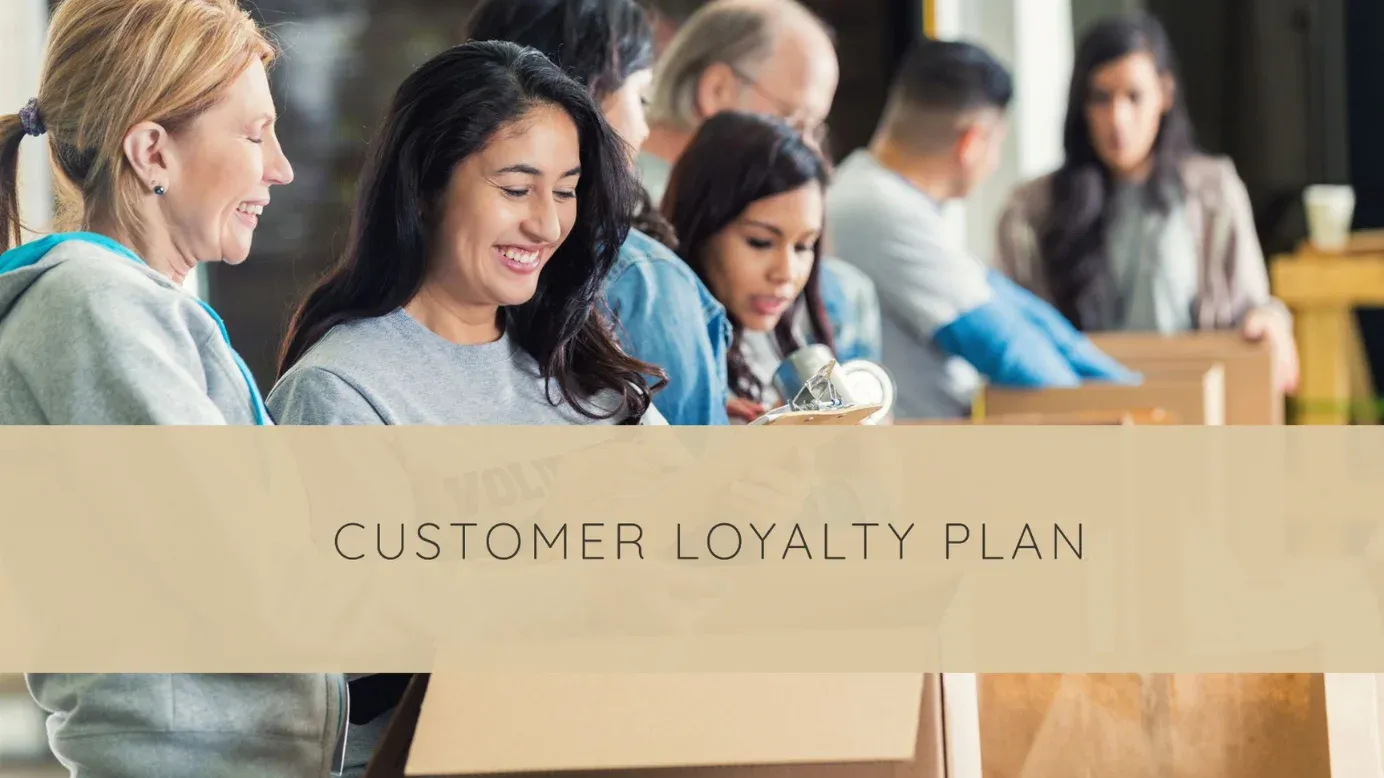On this page
Winning over customers isn't just about making a sale but cultivating lasting relationships. With countless options at their fingertips, consumers are spoilt for choice, making loyalty a prized commodity for businesses. Yet, amidst the pursuit of acquiring new customers, many overlook the goldmine that lies within their existing customer base.
Studies have shown that increasing customer retention by just 5% can lead to a staggering 70% increase in profits. Yes, you read that right. This statistic alone underscores the immense value of prioritizing customer loyalty in your business strategy.
But how exactly do you go about creating a customer loyalty plan that not only retains but delights your customers, setting you apart from the competition? This is precisely what we aim to explore in this comprehensive guide. From understanding the fundamentals of customer loyalty to implementing actionable strategies tailored to your unique business, we're here to equip you with the tools and insights you need to thrive in today's dynamic marketplace.
So, let’s find out the secrets to crafting a customer loyalty plan that not only drives profitability but also fosters meaningful connections with your most valuable asset–your customers.
What are customer loyalty plans?
A customer loyalty plan is strategy businesses employ to encourage repeat purchases and foster brand loyalty among their customers. These plans typically offer rewards, incentives, or benefits to customers who consistently engage with a brand or make frequent purchases. The goal is to enhance customer satisfaction, increase retention rates, and boost sales.
The key components of a customer loyalty plan
A well-crafted customer loyalty plan is essential for businesses looking to retain their existing customers and foster long-term relationships. Here are the key components of a customer loyalty plan:
1. Rewards system
A rewards system is the foundation of a customer loyalty plan. It involves offering customers incentives such as points, discounts, or freebies based on their purchase behavior. Here are the different types of reward systems that you can consider implementing:
- Points-based programs: Customers earn points for every dollar spent. These points can be accumulated and redeemed for discounts, free products, or special services. For example, a coffee shop might give one point per dollar spent, and after collecting 100 points, the customer gets a free beverage.
- Purchase-based rewards: Customers receive rewards after a certain number of purchases. For instance, a sandwich shop might offer a free sandwich after the purchase of ten sandwiches.
- Cashback offers: Customers receive a percentage of their purchase amount back as credit. For example, a retail store might offer 5% cashback on all purchases made with a store-branded credit card.
- Discount coupons: Offering discount coupons after purchase or as a reward for loyalty can incentivize customers to return. For instance, a clothing store might send a 20% off coupon for the next purchase after a customer spends $100.2. Tiers of membership
Creating different membership levels within a loyalty program adds an element of gamification, encouraging customers to reach higher tiers for better rewards. Here’s how tiered membership can be structured:
- Entry-Level Tier (e.g., Bronze or Silver): This tier offers basic benefits such as occasional discounts and early access to sales.
- Mid-Level Tier (e.g., Gold): Provides more substantial rewards, such as higher points accumulation rates, free shipping, and birthday gifts. Customers might need to spend a certain amount annually to reach this tier.
- Top-Level Tier (e.g., Platinum or Diamond): This tier includes premium benefits such as exclusive event invitations, personal shopper services, and the highest points accumulation rates. Entry into this tier might require significant annual spending or accumulated points.
3. Exclusive offers
Providing special deals and promotions exclusively for loyalty program members helps to make customers feel valued and appreciated. Examples include:
- Members-only sales: Hosting sales events that are exclusively available to loyalty program members, offering them first dibs on discounts and new products.
- Exclusive product launches: Giving loyalty members early access to new products before they are available to the general public.
- Special discounts: Offering members periodic or seasonal discounts that non-members do not receive. For instance, a beauty retailer might give loyalty members an extra 10% off during holiday sales.
4. Personalized experience
Tailoring rewards and communication to match customers' individual preferences can enhance the loyalty program's effectiveness. Here’s how personalization can be achieved:
- Customized offers: Using purchase history and customer preferences to send personalized offers and recommendations. For example, an online bookstore might suggest books based on previous purchases and offer discounts on those genres.
- Personalized communication: Sending personalized emails and messages that address the customer by name and reflect their interests. For instance, a sports retailer might send personalized emails about sales on the customer’s favorite sports gear.
- Birthday and anniversary rewards: Offering special discounts or gifts on customers’ birthdays or anniversaries of their membership signup.
5. Referral bonuses
Referral programs encourage existing customers to bring in new customers by rewarding both the referrer and the referee. Here’s how referral bonuses can be structured:
- Bonus points: Giving extra loyalty points to customers who refer friends and family. For example, a fitness club might offer 50 points for every new member referred.
- Discounts or freebies: Providing discounts or free products/services to both the referrer and the new customer. For instance, a meal delivery service might offer a free meal to both parties when a new customer signs up using a referral code.
- Tiered referral rewards: Offering increasing rewards based on the number of successful referrals. For instance, a software company might provide a month of free
Benefits of customer loyalty plan worth considering
Here are the benefits of customer loyalty plans that are worth considering.
1. Increased customer retention
When businesses offer ongoing incentives, such as discounts, points, or exclusive deals, customers are likely to return. It's like giving them a good reason to stay loyal to the brand instead of shopping around with competitors.
For example, if you know that buying your favorite coffee will get you a free drink after a few visits, you're more likely to return to that coffee shop.
2. Enhanced customer engagement
Regular rewards and special perks keep customers interested and engaged with the brand. This might include early access to new products, members-only sales, or birthday treats. These rewards make customers feel valued and appreciated, encouraging them to interact more with the brand.
For instance, if a clothing store offers you a special discount on your birthday, you’re more likely to visit and purchase.
3. Higher spend per customer
Loyal customers spend more money, especially when they know they are earning rewards. If customers are close to earning a reward, they might make an extra purchase to reach that goal.
For example, if you need a few more points to get a free meal at a restaurant, you might dine there more often.
4. Positive word-of-mouth
When customers are happy with their rewards and benefits, they are likely to tell their friends and family about it. This positive word-of-mouth can bring new customers to the brand.
For instance, if you love the loyalty program at your favorite bookshop, you might recommend it to a friend who becomes a new customer.
5. Increased customer lifetime value
Loyal customers are more valuable over time. They continue to generate revenue for the business through repeat purchases and are more likely to try new products or services from the brand.
How to successfully create and implement a customer loyalty plan
Implementing a customer loyalty plan can be a great way to retain customers and increase sales. Here is a step-by-step guide to help you effectively implement your loyalty plan:
1. Understanding your audience
- Market research and customer segmentation in the US
To create a successful customer loyalty plan, you must first identify your target audience. You can obtain useful information on tastes, purchase patterns, and demographics by carrying out in-depth market research.
This frequently entails examining a wide range of consumer bases from various age groups, financial brackets, and geographic locations in the market. You may customize your loyalty programs to each group's unique wants and preferences by segmenting your audience, which will make sure that your efforts are effective and relevant.
- Identifying customer needs and preferences
Analyze your audience's demands and preferences in more depth after you have divided them into smaller groups. Surveys, focus groups, and comments from customer service interactions can all help achieve this. Knowing what drives your customers, for example, discounts, early access, or superior service enables you to create customer loyalty plans that appeal to them.
2. Building trust and relationships
- Importance of trust in customer loyalty
Gaining and keeping a customer's confidence is essential for fostering customer loyalty in a market where there is no shortage of options.
Customers are more inclined to stick with trustworthy brands because they want to do business with organizations that exhibit dependability, honesty, and integrity. Customers may easily become unsatisfied with a company and turn to rivals due to a lack of trust.
- Strategies for building trust with customers
Open communication is the first step towards developing trust. Make sure that your marketing messaging reflects the real customer experience and that you are realistic about your policies, goods, and services. Another essential component is offering first-rate customer service and addressing questions and concerns on time.
3. Personalization in loyalty plans
- Significance of personalized experiences
Customers demand that brands will recognize and accommodate their personal preferences. Tailored customer loyalty plans boost consumer happiness and engagement by making them feel valued and appreciated.
91% of consumers are more likely to purchase from brands that offer recommendations and offers that are appropriate to their needs, per an Accenture survey. This illustrates how personalization may greatly increase the loyalty and retention of customers.
- Implementing personalization in customer loyalty plans
Utilize client data to begin implementing personalization in your reward programs. Customize rewards and offers based on demographic data, browsing habits, and past purchases. For example, give a customer a personalized discount on a product they usually purchase or suggest new products based on their previous purchases. Create personalized marketing efforts by segmenting your audience with CRM (Customer Relationship Management) technologies.
Think about using personalized communication as well, including sending emails addressing clients by name and providing tailored messages. You may establish a more significant and enduring relationship with your customers by tailoring your customer loyalty plan to feel unique and related to them.
4. Communication and engagement
- Importance of communication in loyalty programs
A closer bond between your brand and your customers is created via meaningful and consistent interactions that keep them informed and involved. Building trust, informing clients of the advantages of the loyalty program, and promoting active participation are all facilitated by clear communication.
The "Share a Coke" commercial from Coca-Cola emphasizes the value of remarkable communication. Coca-Cola encouraged people to share personalized bottles with friends and family by substituting well-known names for its logo. Along with increasing sales, this campaign cultivated a personal rapport with consumers, strengthening their connection to the brand.
- Effective communication strategies for customers
The first step in having an efficient consumer communication strategy is to implement a multi-channel strategy. To reach customers where they are most engaged, use in-store notifications, social media, mobile apps, and email. Make your messaging interesting and relevant by emphasizing the special advantages and benefits of your customer loyalty plans.
Encourage two-way contact by asking for input from customers and actively addressing their questions and issues. To maintain consumer engagement and motivation to participate in the program, inform them on a regular basis about their loyalty status, new incentives, and exclusive promotions.
5. Rewards and incentives
- Types of rewards and incentives customers respond to
Creating an effective customer loyalty plan requires knowing what kinds of incentives and rewards appeal to your target market. Though conventional incentives like freebies and discounts work well, think about providing experience benefits like early access to new products, VIP event access, or access to special products.
Furthermore, gamification components like badges, points, and tiered reward systems might entice users to interact with your program more enthusiastically.
- Designing reward structures that appeal to the audience
Take your target audience's tastes and behaviors into account while creating your reward system. Divide up your clientele so that you can provide incentives that are relevant and appealing to the various groups. Use tiered systems to offer rewards for more spending and involvement.
Analyze consumer comments and data regularly to improve your reward programs and modify them for shifting tastes. You can increase engagement and cultivate enduring loyalty by constantly refining your incentive program to suit the changing needs of your audience.
6. Feedback and adaptation
- Importance of feedback in improving loyalty plans
A useful tool for improving and fine-tuning customer loyalty plans is feedback. Businesses can discover areas for improvement and the efficacy of their programs by asking and listening to client feedback.
Comprehending client preferences, issues, and recommendations empowers organizations to develop data-driven choices that improve customer satisfaction and fortify brand loyalty.
- Collecting and analyzing customer feedback in the market
Businesses can use a variety of channels, including surveys, feedback forms, social media, and customer service contacts, to gather insightful client feedback. Businesses can find trends, patterns, and areas of concern by analyzing this input.
Gaining a thorough grasp of consumer sentiment and satisfaction levels requires considering both quantitative measures, like Net Promoter Score (NPS), and qualitative insights.
Netflix leverages user feedback to make ongoing service improvements. Netflix can make personalized movie and series recommendations by examining feedback and watching patterns, which increases consumer pleasure and loyalty. Being open for feedback ensures that they stay in step with customer preferences, which keeps them ahead of rivals.
- Improvement and adaptation of loyalty plans
With the use of client feedback, companies may refine and modify their loyalty programs to better suit the requirements and preferences of their target market. This could entail making adjustments to the reward program, adding new features, or resolving customer-identified problems.
It is ensured that loyalty programs continue to be powerful, relevant, and engaging in fostering client loyalty by routinely assessing and improving them. Through prioritizing customer feedback-driven continuous improvement, businesses can construct more robust and successful customer loyalty plans that cultivate lasting connections with their clientele.
Measuring success
- Analyzing ROI and customer lifetime value
Evaluating the effectiveness of a loyalty program necessitates looking at important data like ROI and CLV (customer lifetime value). ROI compares the gains made to the expenses incurred to determine how profitable your customer loyalty plans are.
CLV calculates the overall revenue a client brings in during their connection with your company, giving you valuable information about the long-term worth of your loyal clients. Businesses may assess the financial results of their loyalty programs and make well-informed decisions regarding resource allocation and future investments by monitoring these measures.
- Continuous monitoring and adjustment
By keeping a close eye on important performance metrics, companies can evaluate the success of their loyalty programs over time and pinpoint areas for development. Businesses can adjust their tactics in response to shifting client preferences and market dynamics by remaining flexible and responsive.
Loyalty programs must be reviewed and adjusted regularly to stay in line with corporate objectives and produce significant outcomes. Businesses may maximize their loyalty programs for long-term success and continuous client satisfaction by continuing to take a proactive approach to monitoring and modification.
American Express tracks ROI and Customer Lifetime Value (CLV) to evaluate the effectiveness of its membership rewards program. Amex may evaluate the long-term profitability of its loyalty initiatives and make data-driven decisions to optimize its services by examining the spending patterns of members of incentive programs.
Building scalable customer loyalty plan with Loyalife: A holistic customer loyalty platform
Loyalife provides a robust end-to-end infrastructure that enables businesses to efficiently build scalable customer loyalty programs. The platform's offerings are designed to cater to various aspects of loyalty program management, including customer engagement, analytics, insights, and API integrations for seamless operations.
👉 Customer engagement: Loyalife's platform facilitates deep customer engagement through an extensive rewards redemption and exchange marketplace. This allows businesses to offer personalized rewards, fostering stronger connections and enhancing customer satisfaction.
👉 Analytics and insights: Loyalife leverages advanced analytics tools to give businesses crucial insights into customer behaviors and loyalty trends. This feature supports businesses in making data-driven decisions that optimize their loyalty strategies and improve customer retention rates.
👉 API integrations: Loyalife's platform includes comprehensive API integrations, ensuring compatibility with existing business systems. This integration capability supports the scalability of loyalty programs by enabling seamless interactions between different software systems, thus enhancing operational efficiency.
- 👉Customization and flexibility: The platform offers high levels of customization, allowing businesses to tailor their loyalty programs according to specific brand requirements and customer needs. This flexibility ensures businesses can effectively adapt to changing market conditions and customer preferences.
To discover how Loyalife can transform your customer loyalty strategies and help you build a more connected and rewarding customer experience, visit Loyalife's Loyalty Management Solutions today. Take the first step towards a more engaged and loyal customer base. Want to know more? Connect with our loyalty management experts.
Check out how the Largest Bank in Qatar partnered with Loyalife to create a scalable loyalty program that drives engagement and enhances customer retention. Through a points-based rewards system, personalized offers, and tiered benefits, the program ensures a seamless and rewarding experience. Members enjoy exclusive perks, from priority services to VIP access, while a digital platform simplifies tracking and redemption.
This innovative approach has strengthened customer relationships and boosted satisfaction, showcasing Loyalife's ability to deliver impactful, customer-centric loyalty solutions that scale effortlessly.
Conclusion
As we've seen, customer loyalty plans are more than just a marketing tool; they're a bridge connecting businesses to their customers meaningfully. By offering rewards, special perks, and personalized experiences, these programs encourage repeat business and build a community of engaged and satisfied customers.
Remember, understanding and responding to your customers' needs and desires is key to a successful loyalty plan.
So, take what you’ve learned here and consider how to apply it to create a loyalty program that resonates with your audience. This will ensure that they feel valued and keep coming back for more.
FAQ's
What role does technology play in customer loyalty plans?
Technology enables seamless implementation and management of loyalty programs through digital platforms, making it easy to track rewards, personalize offers, and analyze customer behavior.
Why are customer loyalty plans important for businesses?
These plans foster long-term relationships with customers, improve retention, and encourage repeat purchases, ultimately driving business growth and profitability.
What is a loyalty program implementation plan?
A loyalty program implementation plan outlines the steps to design, launch, and manage a customer loyalty program, including goal setting, choosing rewards, integrating technology, and measuring success.
How can businesses earn customer loyalty?
Businesses can earn loyalty by providing excellent customer service, delivering quality products, personalizing experiences, and consistently exceeding customer expectations.
What are effective strategies to increase customer loyalty?
Strategies include offering personalized rewards, creating tiered loyalty programs, leveraging data to improve experiences, and engaging customers through exclusive events or perks.
How can real estate companies increase customer loyalty?
Real estate businesses can boost loyalty by offering referral rewards, providing value-added services like property maintenance, personalizing communication, and maintaining strong relationships post-sale.









